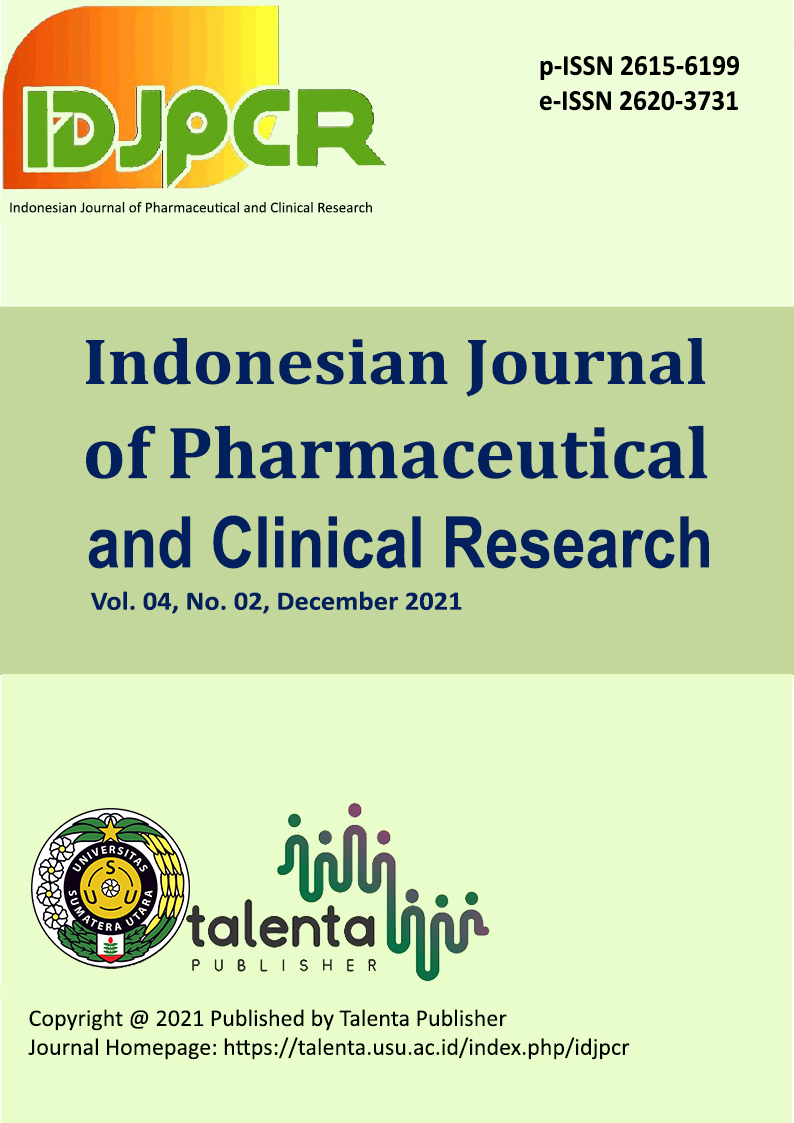Plasmodium Resistance to Artemisinin Derivates due to Kelch-3 Gene Mutation
DOI:
https://doi.org/10.32734/idjpcr.v4i2.6332Keywords:
Antimalaria, resistance, artemisinin, plasmodium, mutationAbstract
Artemisinin class of antimalarial drugs play an important role in controlling falciparum malaria after the emergence of resistance of Plasmodium falciparum to other antimalarial drugs such as chloroquine, sulfadoxine-pyrimethamine and mefloquine. Therefore, the presence of Plasmodium falciparum resistance to this class of drugs is threat to global efforts to eliminate this disease. Resistance of Plasmodium falciparum to artemisinin recently known to be associated with mutations in the propeller domain of the kelch-13 (K13) Plasmodium falciparum gene. The incidence of Plasmodium falciparum resistance due to mutations in the K13 gene, among others, can be found in Cambodia, Laos, Vietnam, China, Myanmar, Thailand and Africa. The presence of mutations in this gene will change the response of Plasmodium falciparum against oxidative stress induced by artemisinin by involving the proteasome-ubiquitin pathway. In addition, mutation K13 will also change the levels of PI3K and PI3P in the body of Plasmodium falciparum. PI3K and PI3P are lipids that essential for the development of Plasmodium falciparum from ring stage to schizont. Resistance to artemisinin will also provide phenotypic changes in the life cycle of Plasmodium falciparum in the form of elongation at the stage ring and transient shortening in trophozoite development. This resistance incident can be overcome, among others by prolonging the duration of treatment (from a 3-day regimen to a 4-day regimen) and combining artemisinin with proteasome inhibitors.
Downloads
References
Thu AM, Phyo AP, Landier J, Parker DM, Nosten FH. Combating multidrugresistant Plasmodium falciparum malaria. FEBS J. 2017;284(16):2569-78.
Hott A, Casandra D, Sparks KN, Morton LC, Castanares GG, Rutter A, dkk. Artemisinin-resistant Plasmodium falciparum parasites exhibit altered patterns of development in infected erythrocytes. Antimicrob Agents Chemother. 2015;59(6):3156-67.
Pandey N, Pandey-Rai S. Updates on artemisinin: an insight to mode of actions and strategies for enhanced global production. Protoplasma. 2016;253(1):15-30.
Dogovski C, Xie SC, Burgio G, Bridgford J, Mok S, McCaw JM, dkk. Targeting the Cell Stress Response of Plasmodium falciparum to Overcome Artemisinin Resistance. PLoS Biol. 2015;13(4):1-26.
Ho WE, Peh HY, Chan TK, Wong WSF. Artemisinins: Pharmacological actions beyond anti-malarial. Pharmacol Ther. 2014;142(1):126-39.
Zaw MT, Emran NA, Lin Z. Updates on k13 mutant alleles for artemisinin resistance in Plasmodium falciparum. J Microbiol Immunol Infect. 2017;51(2):159-16.
Straimer J, Gnädig NF, Stokes BH, Ehrenberger M, Crane A a, Fidock A. Plasmodium falciparum K13 Mutations Differentially Impact Ozonide Susceptibility and Parasite Fitness In Vitro. Am Soc Microbiol. 2017;8(2):1-12.
WHO. Status report on artemisinin and ACT resistance. Geneva: World Health Organization; 2016.
Miotto O, Amato R, Ashley EA, MacInnis B, Almagro-Garcia J, Amaratunga C, dkk. Genetic architecture of artemisininresistant Plasmodium falciparum. Nat Genet. 2015;47(3):226-34.
Fairhurst RM. Understanding artemisininresistant malaria: what a difference a year makes. Curr Opin Infect Dis. 2015;28(5):417-25.
Tilley L, Straimer J, Gnädig NF, Ralph SA, Fidock DA. Artemisinin Action and Resistance in Plasmodium falciparum. Trends Parasitol. 2016;32(9):682-96
Downloads
Published
How to Cite
Issue
Section
License
Copyright (c) 2021 Indonesian Journal of Pharmaceutical and Clinical Research

This work is licensed under a Creative Commons Attribution-ShareAlike 4.0 International License.
The Authors submitting a manuscript do so on the understanding that if accepted for publication, copyright of the article shall be assigned to Indonesian Journal of Pharmaceutical and Clinical Research (IDJPCR) and Faculty of Pharmacy as well as TALENTA Publisher Universitas Sumatera Utara as publisher of the journal.
Copyright encompasses exclusive rights to reproduce and deliver the article in all form and media. The reproduction of any part of this journal, its storage in databases and its transmission by any form or media, will be allowed only with a written permission from Indonesian Journal of Pharmaceutical and Clinical Research (IDJPCR).
The Copyright Transfer Form can be downloaded here.
The copyright form should be signed originally and sent to the Editorial Office in the form of original mail or scanned document.









